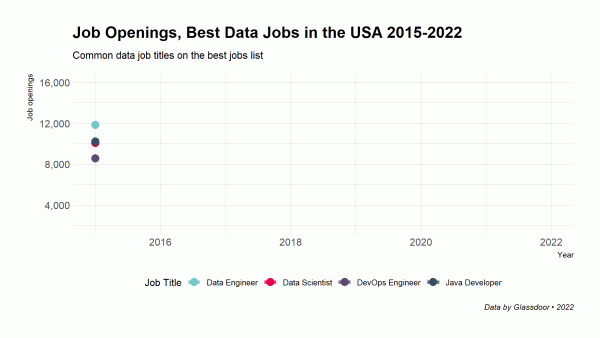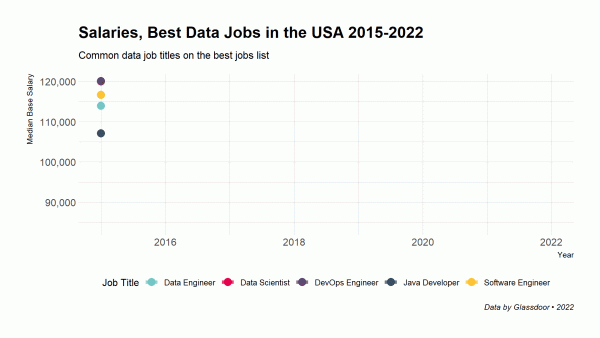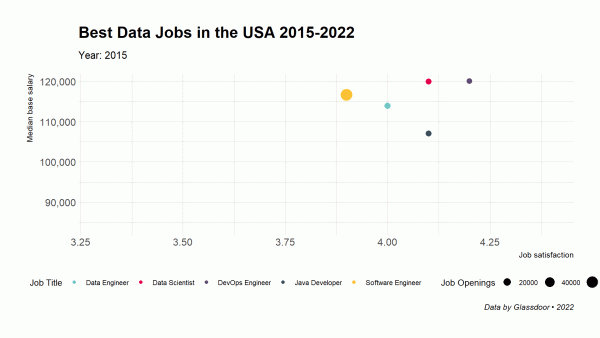Breaking into data science in the post-pandemic world
Our Chief Data Scientist Marianna Pekar talks about her path from Budapest and a degree in finance and quantitative methods to Whanganui-a-Tara and rewarding roles in data science. She explains that the signs are bright for people wanting to break into this field in the post-COVID world.
This is an edited version of a talk Marianna gave at the Women in Data Science New Zealand conference in March 2022, where she aimed to offer some guidance for early-career data scientists or others transitioning into the field.

Marianna Pekar, Chief Data Scientist at MartinJenkins, Women in Data Science New Zealand conference 2022
The year I graduated, 2008, was also the year the Global Financial Crisis hit. I knew it was bad news — several studies since have confirmed that graduating during a recession can affect one’s career for many years to come.
Finance and quantitative studies had provided well-paid careers in post-communist Hungary, which lacked people with skills in many capitalist professions. But amidst the GFC panic, many companies slashed or abandoned their graduate programmes, and I felt my degree in that area had almost instantly become irrelevant.
I added to the difficulties by relocating to New Zealand (motivated by personal rather than professional considerations — falling in love during university). As a graduate in a foreign country with a two-year work permit, it was nearly impossible to get a graduate job. This hit me hard — I felt incredibly unlucky and alone.
Later research showed in fact I wasn’t alone, that my entire generation was affected. The financial crisis had a sustained effect on starting salaries, which took a decade to get back to pre-crisis levels.
A new direction
After some contract jobs and some tutoring at Victoria University, I eventually joined the workforce in New Zealand as a statistical and financial modeller.
I had always loved programming, mathematics, and statistics during university, as well as social sciences and research, but I couldn’t see a profession that brought all those together. That was soon to change.
I have always been a keen reader of business magazines like Harvard Business Review and the MIT Management Review, and in the early 2010s I saw a change of direction in their articles. The exciting term “data science” was not yet mentioned much, but “big data”, “digital transformation”, and “data visualisation” now all started appearing frequently. In October 2012 HBR even called data science “the sexiest job of the 21st century”.
There was also a bottleneck in the field. It was not technological, rather it was the scarcity of professionals who could do more with data than just processing and storing it. That 2012 HBR article also reported that:
“The shortage of data scientists is becoming a serious constraint in some sectors.”
Education systems struggle to catch up
When I started, there were still no formal educational pathways, and few informal ones. Coursera’s famous course, The Data Scientist’s Toolbox, only began around 2014. We also did not have the many great blogs and podcasts now available.
I began by enrolling in the existing courses that I could find. Stanford University had a six-week “Big data” course. It offered no hands-on teaching but it did give me an in-depth understanding of what skills I needed and what I could become.
After that, I never stopped planning what to learn next: I enrolled in Coursera, DataCamp, and edEX courses, and did classroom learning on cloud-computing, SAS coding, and research methods in social sciences. I also participated in research conferences.
Rewarding data science roles in Aotearoa
Since I joined this profession in the mid-2010s, I’ve had a string of rewarding roles.
As a data analyst with the Commerce Commission I helped develop new regulatory regimes, including for electricity distribution and transmission. Later with KPMG I helped that firm establish its own data science arm, its Lighthouse Centre of Excellence for Data Analytics. Immediately before joining MartinJenkins I was Principal Data Scientist with the Social Wellbeing Agency, where I led data assignments and developed data analytics networks.
My current Chief Data Scientist role bridges the gap between management and the data science team: I develop algorithms, methods, and data products and do research, while also being part of the senior management team. The management role involves looking after the firm’s data strategy and ensuring we use data to provide direction, evidence, and additional insights.
The signs are bright
In this new post-pandemic world, is data science still as attractive a profession as Harvard Business Review described back in 2012? There have been some wildly conflicting predictions: some say it is just starting to grow exponentially, while others argue it is fizzling out.
But recruiters do not think anything is changing for the worse. Burtch Works reported increased demand and resilient data scientist salaries in the US in 2021. Talent, another recruitment firm, was similarly optimistic about the Australia–New Zealand market in 2020.
Glassdoor, which collects salary and job-satisfaction data from all professional fields, analyses job openings in the US. Its data shows that after the initial craze, and then the sudden drop in 2016, job openings for data scientists have been on a moderate rise, with 2022 exceeding the highs of 2015. Other highly ranked data jobs, such as data engineer and DevOps engineer, have been following a parallel trajectory.

Salaries and job satisfaction remain strong for data scientists
Salaries for data scientists dipped in 2016 as demand dropped, but since then they have been constantly above other key data jobs, and they have also been on the rise since 2020:

Data scientist is still one of the top jobs on the US market considering job satisfaction as well as salaries. The chart below shows satisfaction on the x axis and salaries on the y, with data scientist occupying the top-right, most favourable quadrant.

The pandemic changed things up
Glassdoor’s data shows that data scientist is still the highest-ranking data job in the US when considering all three key factors: demand, salaries, and job satisfaction.
In the 2010s, education systems caught up with the needs of the labour market, and the gap between high demand for data science skills and inadequate supply was closing. However, the pandemic changed things up, increasing demand in New Zealand and worldwide.
The field now looks just as bright as it did when I entered it in the mid-2010s, and there are no signs that would prompt anyone already in the field to flee and retrain.
Choose a data science knowledge domain that really interests you
You cannot enter this field without good technical skills, and the ones that are most essential are the ones that take the most work to acquire. But my advice is that once you get a formal education in this field, don’t stop there.
Continuous learning has been a core part of my professional life as a data scientist. I am now back being a student at Victoria University, doing a postgraduate diploma in AI. Besides learning about new software and new techniques, I try to learn about and choose projects in the field I am most curious about: computational social science.
If you choose a knowledge domain or area that really interests you, this will guide you in your journey. Acquiring strong skills and understanding in that area will give you your strongest assets, and it will also be the most fulfilling part of your journey.
Have a vision of where you want to be and build your strategy to acquire skills in your specific knowledge domain, because your time is precious, and you can’t and don’t need to be a unicorn — an expert in all things.
I also believe a good workplace culture is essential to you as an early-career data scientist: it will help you maintain a curious mind, spark your creativity, and find passion.
Consistently successful companies frequently have an excellent work culture, and if you see bad culture, turn your back. Remember that you have choices and that there is no stigma in looking after two of your most crucial assets — your time and your mental health.